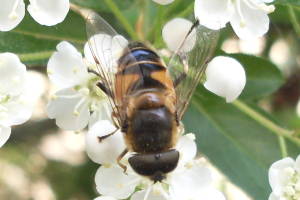Table of contents
Structure - Appearance - BibliographyIn a first approach, in most holometabolous insects the embryonic development may be identified with the egg stage and the postembryonic with the juvenile stages of larva and pupa. This schematic definitition is complicated by the relation between the degree of achievement of embryonic development, the egg life, and the trophic exchange with the mother, so there three basic conditions: the viviparity, the ovoviviparity, and the oviparity. This latter is the most frequent among the Diptera. In oviparous and ovoviviparous insects, the embryonic development accomplishes in the egg; the substantial difference between the two forms is the condition in which the incubation occurs: in the ovoviviparous, the incubation of eggs takes place within the mother, therefore the larvae come out just after the oviposition, while in the oviparous a period elapses from the oviposition to the hatching. In viviparous species, the embryonic development does not complete within the egg and the embryos remain in the mother's body that has special adaptations of the genitalia (uterus).
An important feature in the oviparous and ovoviviparous species is the beginning of the postembryonic development inside the egg, with the presence of the first instar larva in the pharate phase. In some species, the trophic reserves accumulated allow the extension of the development in the egg and the larvae come out as 2nd or rarely 3rd instar.
Structure
The egg is composed of a tegument (chorion), the embryo and its accessories (serosa and amnion), and the nutrient reserves (yolk).
With a few exceptions, p.a. Tachinidae, the eggs of Diptera, are centrolecithal and rich in yolk, as those of most of Insects, and have meroblastic cleavage called superficial. In these eggs the nucleus is surrounded by abundant yolk, placed at the center, and the remaining part of the active protoplasm is confined in a thin peripheral layer. During the early stages of the embryonic development, the nuclei derived from the mitotic activity (blastomeres) move to the periphery and form a plasmodial layer (blastoderm) that surrounds the yolk. At beginning, the blastomeres share a single cytoplasm (meroblastic cleavage) and only at later stage they build the membrane and get an own portion of cytoplasm. The differentiation of the embryo takes place near the micropyle at the beginning of gastrulation: the blastomeres, in this region, become higher and differentiate the germinal plate.
Next time the differentiation of the germ layers occurs and after the genesis of the body systems. At the same time, the embryo has complex movements (blastokinesis) which bring it deep in the yolk, while the remaining part of the blastoderm differentiates the embryonic membranes: the serosa just under the chorion, and the amnion, close the embryo.
The corion is the primary integument, build since the oogenesis. It appears as shell more or less stiff and impermeable, with a structure adapted to control the exchanges with the external environment. It is built before the fertilization, therefore it has one or more openings (micropyles) through which the sperms pass. Other openings (aeropyles) are structurally and functionally predisposed to allow the gas exchanges while preventing he loss of water by evaporation.
Appearance
In several groups, the egg has ovoid or elliptic shape, more or less elongate, with ends usually blunt or rounded, or it may be fusiform, subcylindric, or subglobose. There are also singular shapes (like boat, horseshoe, limpet, etc.). The size is in most cases in the order of one or less than 1 mm, with a variable ratio between length and width. Only rarely the eggs are longer than 2 mm (es. Sarcophagidae).
The color varies considerably throughout the order. It is often pale just after the oviposition, but turns to dark during the embryonic development.
The surface is smooth or has patterns derived from chorionic microsculptures, which usually appear as roughness, longitudinal ribs, more or less regular, or hexagonal reticulation. More rarely there are processes of the corion, as flanges, filaments, barbs, usually near the ends of the eggs. These processes are often related to specific functions based on the biology of the species. Among the special features are reported the coverage with mucilaginous substances, with aggregating or waterproofing functions, or with adhesive substances.
Bibliography
- Darvas, B. & Fónagy, A. (2000) 1.8. Postembryonic and imaginal development of Diptera: 283-363. In Papp, L. & Darvas, B. (eds.) Contributions to a Manual of Palaearctic Diptera. Volume 1. General and Applied Dipterology, Work cited.
- McAlpine, J.F.; Peterson, B.V.; Shewell, G.E.; Teskey, H.J.; Vockeroth, J.R. & Wood, D.M. (1981) Manual of Nearctic Diptera. Volume 1, Work cited.
- McAlpine, J.F.; Peterson, B.V.; Shewell, G.E.; Teskey, H.J.; Vockeroth, J.R. & Wood, D.M. (1987) Manual of Nearctic Diptera. Volume 2, Work cited.
- Papp, L. & Darvas, B. (1997) Contributions to a Manual of Palaearctic Diptera. Volume 2. Nematocera and Lower Brachycera, Work cited.
- Papp, L. & Darvas, B. (1998) Contributions to a Manual of Palaearctic Diptera. Volume 3. Higher Brachycera, Work cited.
- Papp, L. & Darvas, B. (2000) Contributions to a Manual of Palaearctic Diptera. Appendix, Work cited.
- Servadei, A.; Zangheri, S. & Masutti, L. (1972) Entomologia generale ed applicata, Work cited.
- Stackelberg, A.A. (1988) Order Diptera. Introduction: 1-39. In Bei-Bienko, G.Y. & Steyskal, G.C. (eds.) Keys to the Insects of the European Part of the USSR, Volume V: Diptera and Siphonaptera, Part I, Work cited.
Creative Commons BY-NC-SA 3.0 Unported License
(BY: Attribution - NC: Noncommercial - SA: Share Alike).


